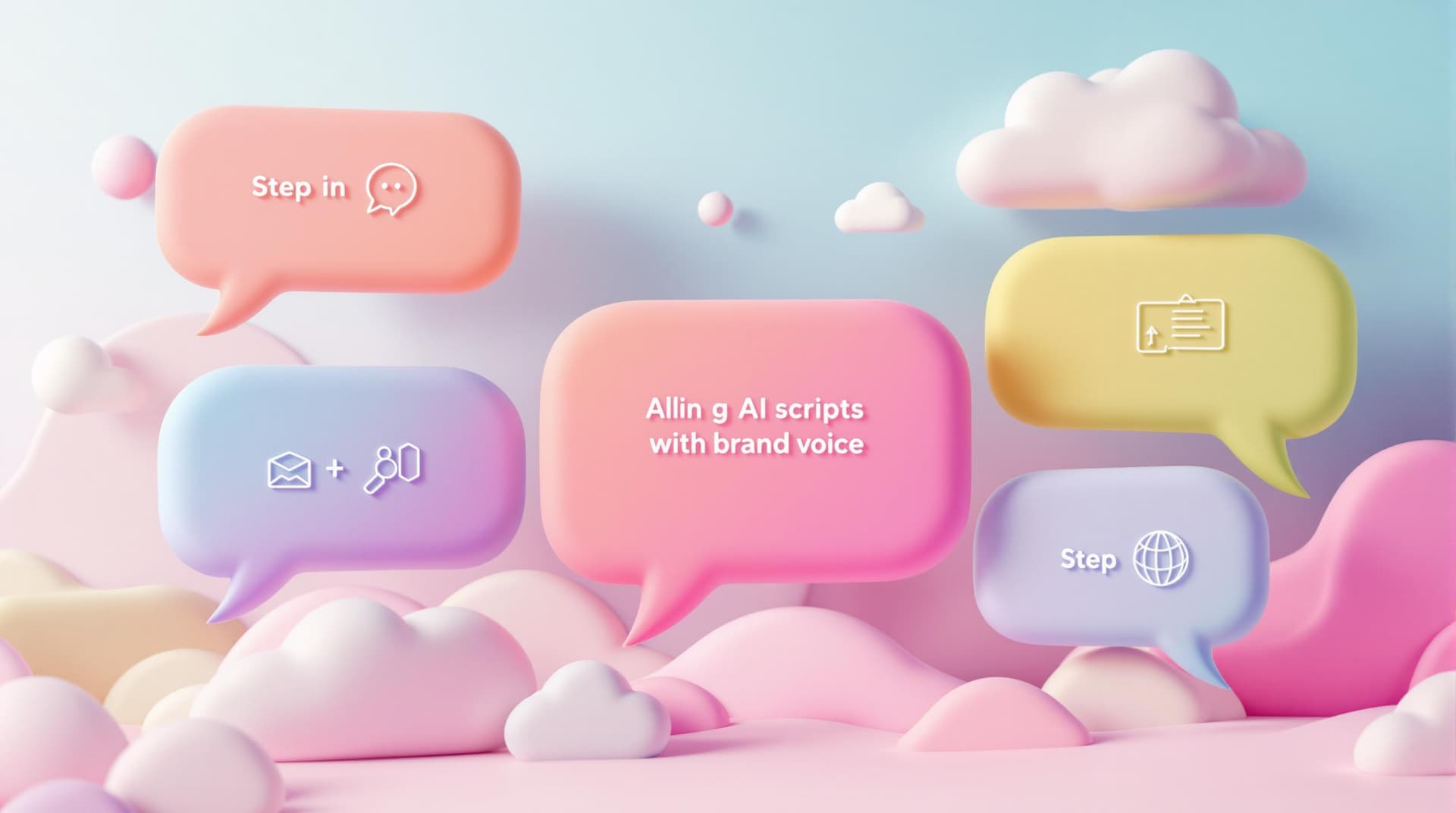Table of contents

AI is transforming content creation, but keeping a consistent brand voice is crucial for trust and recognition. This guide simplifies the process into 5 actionable steps to align AI-generated scripts with your brand:
- Define Brand Voice Rules: Document tone, style, approved terms, and key messages.
- Set Up AI Tools: Input your brand guidelines into AI platforms for accurate alignment.
- Write Clear AI Prompts: Include tone, audience details, and key messages in prompts.
- Review and Edit Scripts: Check tone, messaging, and audience fit for consistency.
- Ensure Consistency Across Platforms: Adjust tone for each platform while keeping your core brand identity intact.
Using ChatGPT to Create Brand Voice Guidelines | AI ...

Step 1: Write Your Brand Voice Rules
Setting clear brand voice guidelines is essential for creating consistent AI-generated scripts. These rules act as a blueprint for any future tweaks to AI settings.
Build Your Voice Guidelines
Start by documenting your brand’s personality and style. Here are some key attributes to include:
Core Voice Attributes
- Personality traits (e.g., friendly, professional, approachable)
- Writing style preferences (e.g., short sentences, simple language)
- Approved language and terminology
- Phrases or tones to avoid
You can also create a table to clarify how your brand voice should come across:
| Voice Element | Do | Don't |
|---|---|---|
| Tone | Write conversationally and warmly | Use overly formal or technical language |
| Language | Use clear, simple words | Include jargon or buzzwords |
| Sentence Structure | Keep sentences concise and direct | Write long, complex paragraphs |
| Messaging | Highlight customer benefits | Focus only on technical features |
"Maintain brand consistency across every video. MagicUGC adapts to your brand voice and style guidelines, so every UGC video looks and sounds like your brand – reinforcing trust and recognition."
Once your voice is clear, move on to defining your core messages.
List Your Key Messages
Focus on these important message elements:
- Your value proposition
- Brand promises
- Key differentiators
- Themes specific to current campaigns
MagicUGC is a great example of how effective these guidelines can be. With a 4.98/5 rating from 10,000 reviews and over 58,980 users trusting the platform, it shows the power of consistent messaging.
When documenting your key messages, break them into these categories:
- Primary Messages: Your main brand promises and values.
- Supporting Points: Evidence or examples that back up your claims.
- Call-to-Actions: Standard phrases to engage your audience.
- Platform Adaptations: Adjustments for different channels or platforms.
Clear brand voice rules ensure AI tools create content that builds trust and strengthens your brand identity.
Step 2: Set Up AI Tools With Your Brand Voice
Once you’ve nailed down your brand voice, it’s time to ensure your AI tools reflect it accurately. This step connects your documented voice to the automated content creation process.
Add Your Brand Voice to AI Tools
Input your brand voice details directly into your AI platform to keep everything aligned:
- Upload your brand voice documentation
- Set preferred tone and style
- Define approved terms and phrases
- Specify any language restrictions
- Include key audience details
Be as clear as possible when providing these guidelines. Here's an example of how to structure them:
| Tone Element | Specific Guidelines |
|---|---|
| Formality Level | Semi-formal with a touch of casual phrasing |
| Technical Terms | Use no more than 2-3 per script |
| Sentence Length | Keep sentences between 15-20 words |
| Emotional Range | Positive and engaging, but not overly cheerful |
Once your guidelines are in place, tweak your AI settings to improve how well the scripts match your brand’s voice.
Fine-Tune AI Settings for Precision
Tools like MagicUGC’s AI Script Optimization feature let you adjust key settings to refine your content:
- Ensure voice consistency
- Adjust emphasis on specific messages
- Adapt content for cultural nuances
- Target specific demographics
- Track performance metrics
Regular updates to these settings are important. Use data like script performance, audience engagement, and brand voice accuracy to make adjustments that fit your current campaign needs.
sbb-itb-d822133
Step 3: Write Better AI Prompts
Include Voice and Audience Details
To get the most out of AI-generated content, combine your brand's voice with clear audience details. A well-structured AI prompt should include specifics about tone, language, audience demographics, and cultural context. Here's how you can break it down:
| Prompt Element | What to Include | Example |
|---|---|---|
| Voice Tone | Formality level, emotional range | "Use a confident yet approachable tone, maintaining professional warmth." |
| Language Style | Word choice, sentence structure | "Write in short, punchy sentences with everyday language." |
| Audience Demographics | Age, interests, pain points | "Target health-conscious women, 25-40, interested in weight loss." |
| Cultural Context | Regional preferences, local references | "Reference US wellness trends and use pounds/inches." |
For example, AI-generated content aimed at women aged 25-40 with an interest in weight loss has shown to significantly improve conversion rates. Adding these details helps align the content with your brand identity while ensuring it resonates with your target audience.
Add Brand Message Requirements
To refine your prompts further, include your brand's key messages directly within the instructions. Focus on these critical elements:
- Core Message Integration: Define your main value proposition and ensure it appears clearly.
- Brand Terminology: Specify words or phrases that must (or must not) be used.
- Campaign-Specific Details: Include relevant hashtags, calls-to-action, or campaign themes.
Be clear and specific to produce content that feels natural while staying on-brand. For example:
"Write a script that highlights our dedication to sustainable wellness in an encouraging, coach-like tone. Use our tagline, 'Transform your health journey,' and incorporate at least two of our core values: transparency, innovation, or community support."
This level of detail ensures every piece of AI-generated content reflects your brand's voice and values.
Step 4: Check and Edit AI Scripts
Match Scripts to Guidelines
Carefully review each part of the script to ensure it aligns with your brand’s voice and style. Focus on tone, messaging, and consistency. Use this table to guide your review process:
| Review Element | What to Check | Action Items |
|---|---|---|
| Voice Consistency | Tone alignment and word choice | Compare with your brand guidelines; flag anything that feels off-brand. |
| Brand Messaging | Key value propositions and terminology | Confirm required phrases are included; remove any restricted terms. |
| Audience Fit | Demographics targeting and cultural relevance | Adjust language to better connect with your audience. |
| Platform Context | Channel-specific requirements | Adapt content to fit the unique constraints of each platform. |
For instance, EcoClean Solutions achieved a 275% boost in ad conversions and reduced acquisition costs by 40% by refining their scripts to better match their brand and audience. Once your script checks all these boxes, focus on improving its flow to make it sound more conversational.
Make Scripts Sound Natural
Once you’ve ensured the script aligns with guidelines, the next step is to make it engaging and easy to follow. Here are some ways to refine the delivery:
- Rhythm Adjustment: Mix up sentence lengths and structures to create a natural, conversational tone while maintaining professionalism.
- Emotional Resonance: Add subtle emotional elements that reflect your brand’s personality and connect with the audience.
- Contextual Refinement: Adapt the script to fit its platform. For example, optimizing scripts for specific channels has been shown to increase sales by 15%.
Leverage tools that help with demographic and cultural adjustments to simplify this process. Finally, read the script out loud to catch any awkward phrases or unnatural flow. This step ensures the final delivery feels smooth and authentic.
Step 5: Keep Voice Consistent Everywhere
Once you've refined your scripts, it's time to ensure your brand voice stays consistent across all content platforms. A unified voice helps your audience recognize and connect with your brand, no matter where they encounter it.
Set Platform-Specific Rules
Each social platform has its own vibe, audience expectations, and content formats. Crafting platform-specific voice guidelines lets you stay true to your brand while tweaking your tone to fit each channel.
Here’s how to adjust your voice for different platforms:
| Platform | Voice Adjustment | Key Focus Area | Example Adaptation |
|---|---|---|---|
| Visual-first, emotional | Short, engaging captions | Use concise, heartfelt messaging to connect with your audience. | |
| TikTok | Casual, trendy | Quick, entertaining hooks | Adopt a conversational tone while staying aligned with your brand values. |
| Community-focused | Detailed, informative | Combine professionalism with a relatable touch. | |
| Professional, authoritative | Industry insights | Keep it formal yet approachable to share expertise. |
The goal is to keep your core brand personality intact while making slight adjustments for each platform. For example, your tone on TikTok might be more casual and playful, but it should still reflect the same brand values you showcase on LinkedIn.
Once these platform-specific rules are in place, you can streamline your content creation process with standardized templates.
Make Standard Video Templates
Standardized video templates make it easier to maintain consistent messaging and branding across platforms. These templates act as blueprints, ensuring every video aligns with your voice and goals, no matter the campaign or platform.
How to create effective templates:
- Identify key elements like intro hooks, main messages, and calls-to-action, and tailor them to each platform.
- Embed voice guidelines into the templates to keep tone and style consistent during content creation.
For example, MagicUGC's AI-powered Boost™ feature showed that consistent templates could lead to better results. Beta users reported a 275% increase in conversion rates.
Here’s what your templates should include:
| Template Element | Purpose | Implementation Guide |
|---|---|---|
| Voice Markers | Ensure tone consistency | Add specific phrases and terminology unique to your brand. |
| Demographic Settings | Align with your audience | Adjust language and style to match different audience groups. |
| Cultural Adaptations | Stay relevant globally | Modify content to fit the cultural context of each market. |
| Performance Metrics | Measure success | Track engagement and conversion data for continuous improvement. |
Conclusion: Making AI Scripts Match Your Brand
Aligning AI scripts with your brand voice helps create stronger connections with your audience. By using brand voice guidelines alongside AI tools, you can produce content that resonates, saves time, and optimizes resources. This combination shows how integrating a clear brand voice with AI can lead to measurable results.
Results of Better AI Scripts
The effectiveness of AI-driven content creation becomes clear when scripts are aligned with your brand. Here's a quick look at some proven outcomes:
| Performance Metric | Impact |
|---|---|
| Conversion Rate Increase | 275% boost with MagicUGC Boost™ |
| Brand Trust | 4.98/5 rating from over 10,000 reviews |
| Content Consistency | 58,980+ users maintaining brand standards |
"Guarantee brand integrity with no risk. Our AI platform ensures compliance, data privacy, and consistent brand voice across every UGC video"
Key advantages of aligning AI scripts with your brand include:
- Building audience trust: Consistent messaging reinforces credibility.
- Boosting engagement: On-brand content connects better with viewers.
- Streamlining production: AI tools speed up the content creation process.
- Maximizing ROI: Well-aligned content leads to higher conversion rates.



